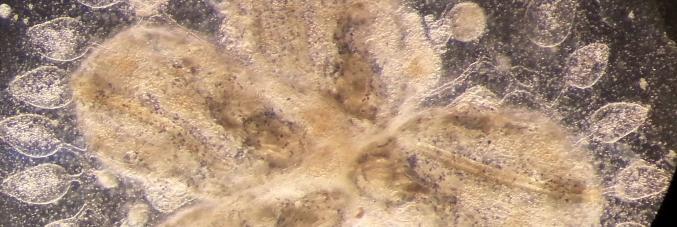
A Unipd-Stanford study: how a small marine invertebrate aids in understanding Alzheimer’s and Parkinson’s disease
15.07.2022
Commonly found in our seas, tunicates are small marine invertebrates and the closest relatives of vertebrates, including humans. Botryllus schlosseri are tunicates that form small colonies in which the adult individuals gather like the petals of a flower. Asexual reproduction allows them to form hundreds of flowers, as each adult develops one or more small individual buds on the sides of its body. The adult colonial organisms are reabsorbed and replaced by their newly matured buds weekly. In this cyclical replacement process, where each "adult" produces more than one bud, the colony grows rapidly and continuously. However, if the adults have a short life span and are continuously replaced by new individuals, the colony does not live forever. In the waters of the Venetian Lagoon, they typically die after 1-2 years, but in the laboratory, they can be kept alive for much longer.
This simple marine animal is at the center of the article "Two distinct evolutionary conserved neural degeneration pathways characterized in a colonial chordate," written by a team of researchers from the Department of Biology at the University of Padua and Stanford University. Published in PNAS, the study is part of a larger collaboration with the Chan Zuckerberg Biohub of San Francisco. The study shows that the degeneration of the brain of this marine animal is similar to that of humans. Understanding the process that leads to the decay of their nervous system and their evolutionary origin could help scientists understand the evolutionary and often debilitating effects of neurodegeneration for a growing number of people.
Using Botryllus schlosseri as an experimental model offers us the extraordinary possibility of studying brain degeneration both in the short term (weekly life cycle) of reabsorption of adult individuals which entails their rapid aging, and in the long term (aging process of the entire colony) that can reproduce and expand new life.
Coordinated by the University of Padua Ph.D. graduate Chiara Anselmi (current Stanford University post-doc), the study includes Lucia Manni of the Biology Department of the University of Padua, and Ayelet Voskoboynik and Irv Weissman of Stanford University.
The study took models from the Hopkins Marine Station in Monterey Bay in California and from the Venetian Lagoon, which were reared at the Chioggia Hydrobiological Station and the Biology Department of the University of Padua.



